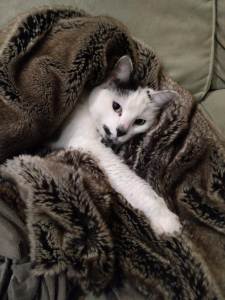This is an update on the post I did several years ago here (it still has a lot of great info!)
Here in Utah we’ve been very lucky to have a warm and dry (maybe too dry? We’re actually in an extreme drought) autumn. But, of course, all nice things have to end eventually and we’re expecting a drop in temperatures tonight. I always worry about animals in cold temperatures as I’ve seen so many animals with frostbite damage in my veterinary work. Hopefully this post will help keep some kitties more comfortable!
A quick word before we get to the cold weather info: TNR (trap-neuter-release; this term works for spaying females too) is another of the kindest things you can do for an outdoor cat. Period. Many clinics, rescues, and vet clinics offer low cost or free feral/barn cat sterilization surgeries and vaccines. If you see a cat outdoors with a tipped left ear (literally missing the tip of the ear) it means the cat has been sterilized. TNR reduces the chance of injuries to the cat (less fighting over territory), reduces the number of unwanted kittens that overrun shelters, and extends the life of the cat. For more info on TNR check out the Alley Cat Allies site here.
Feral cats, barn cats, and even lost indoor cats are at risk for frostbite (which can permanently damage ears, toes, and even cause nerve damage) and cold weather can exacerbate underlying conditions (like asthma, heart conditions, or other ailments). The best thing you can do for outdoor cats is to provide 3 things: sturdy shelter, food, and non-frozen water.
Shelter: this can be as simple as a box and as complex as a fully-built complex. (Many community feral cat rescues offer plans or even boxes you can use, check out one plan here). Chewy or Amazon also offer pre-built heated outdoor shelters. One of the best semi-permanent shelters uses a couple plastic tote bins, some Styrofoam, straw, and something to keep it slightly elevated off the ground and something to keep the lid on. The refletix (metal-looking bubble wrap) that comes with some cold grocery deliveries (or can be purchased from a home supply store) can also add an additional layer of moisture-proof insulation.
The image below shows how to make a good shelter, my only edit would be if you live in an area with dogs, foxes, or coyotes, there should also be a second hole cut for an exit. Make sure the shelter is both secure (it won’t blow over in heavy winds) and in a safe place. Elevating the shelter on some lumber or even bricks will help keep the box warmer. Straw is the best insulator as it repels rather than absorbing water or moisture. Be sure to check whatever box you use for interior moisture and switch out straw if it gets wet. (You can find straw at places like Tractor Supply or gardening stores. If you’re keeping extra make sure to keep it covered with a tarp or in a shed to keep moisture out).
Smaller is better for shelters: the more air space, the more cold that can get in. Make sure snow or ice isn’t accumulating in the shelter and that, during or after snowstorms, that the entrance and exit are both accessible and not blocked. Never put food or water inside the shelter, these can attract predators or pests.

Food and water: keep all food and water away from the shelter. If possible, place these under a roof or even in a plastic tub on its side for a makeshift cover to keep rain or snow out. Dry food is best as it will not freeze. Water is essential in the winter, and cats will not get moisture from snow. A heated water bowl works well, or even putting a water bowl inside an insulated bin cut to the size of the bowl will keep water from freezing quickly. Bird bath or pond warmers work as well for larger bowls. If you have a pond or water feature and use a warmer to keep it from icing over, cats can drink from it as well. Animals need extra calories in the winter, so check food and water supplies frequently. If you will be out of town or expect to be limited in feeding due to a storm, put out extra food or ask a friend or neighbor to help you with feeding. Food supplies in winter can be the difference in the survival of an animal.

Antifreeze and deicing salt: remember to never leave antifreeze accessible to animals as it is very toxic and will cause death if ingested. If it is spilled, use materials (like absorbent cat litter) to absorb it and then discard it. Deicing salts can also have heavy metals or other materials that are toxic to cats (and dogs) when they step on it and then groom themselves. Be sure any deicing materials used are pet safe.
A final word, cats and other small animals sometimes crawl into engine blocks to stay warm. Be sure to tap on your hood before starting your car! I have seen kitties injured by fan belts from crawling into engines, and it’s not pretty. Better to check before starting!
